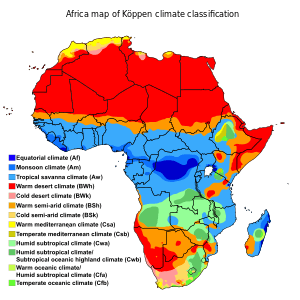Climate change in Africa
Climate change in Africa pertains to aspects of climate change within the continent of Africa.

General
According to Schneider et al. (2007), Africa is likely to be the continent most vulnerable to climate change.[1] With high confidence, Boko et al. (2007) also projected that in many French countries and regions, agricultural production, food security and water stress would likely be severely compromised by climate change and climate variability.[2]
East Africa
Weather conditions over the Pacific, including an unusually strong La Niña, interrupted seasonal rains in East Africa for two consecutive seasons, precipitating in 2011 the worst drought in the region seen in 60 years.[3] In many areas, the precipitation rate during the main rainy season from April to June, the primary season, was less than 30% of the average of 1995–2010.[4]
In 2012, American researchers uncovered a link between the region's low rainfall and changes in the sea surface temperature of the tropical Pacific Ocean, which they suggested was largely responsible for the disruption of the long rains. The discovery is reportedly contributing significantly toward improved forecasts and emergency preparedness.[5]
Sahel
15 per cent of Sahel region population experienced a temperature increase of more than 1 °C from 1970 to 2010. The mean seasonal rainfall is also below the long-term average, and flooding has increased in frequency and severity. Since 1985, 54 per cent of the population has been affected by five or more floods in the 17 Sahel region countries.[6]
In 2012, severe drought conditions in the Sahel were reported. Governments in the region responded quickly, launching strategies to address the issue.[7]
IPCC Sees Severe Climate Change Impacts on Africa
As climate change increasingly affects the world, Africa is at risk of facing severe impacts given its geographical position and limited adaptive capacity, exacerbated by widespread poverty and low levels of development. The Sahel region, in particular, will experience higher average temperatures over the course of the 21st century and changes in rainfall patterns, according to the Intergovernmental Panel on Climate Change (IPCC). These trends will affect the frequency and severity of floods, droughts, desertification, sand and dust storms, desert locust plagues and water shortages.[8]
See also
External links
- UNHCR Global Appeal 2012-2013 - Africa regional summary 1 December 2011, 6 p.
References
- ↑ Schneider, S.H.; et al. (2007). "19.3.3 Regional vulnerabilities". In Parry, M.L., et al. (eds.). Chapter 19: Assessing Key Vulnerabilities and the Risk from Climate Change. Climate change 2007: impacts, adaptation and vulnerability: contribution of Working Group II to the fourth assessment report of the Intergovernmental Panel on Climate Change (IPCC). Cambridge University Press (CUP): Cambridge, UK: Print version: CUP. This version: IPCC website. ISBN 0-521-88010-6. Retrieved 2011-09-15.
- ↑ Boko, M.; et al. (2007). "Executive summary". In Parry, M.L., et al. (eds.). Chapter 9: Africa. Climate change 2007: impacts,. Cambridge University Press (CUP): Cambridge, UK: Print version: CUP. This version: IPCC website. ISBN 0-521-88010-6. Retrieved 2011-09-15.
- ↑ "The worst drought in 60 years in Horn Africa". Africa and Europe in Partnership. Archived from the original on 2 November 2011. Retrieved 2 August 2011.
- ↑ "Eastern Africa: Humanitarian Snapshot" (PDF). 24 June 2011. Archived from the original (PDF) on 21 September 2011. Retrieved 21 July 2011.
- ↑ Nakweya, Gilbert. "Africa: Study Links Drought to Pacific Sea Temperature". AllAfrica. Retrieved 23 July 2012.
- ↑ Livelihood Security Climate Change, Migration and Conflict in the Sahel 2011
- ↑ Fominyen, George. "Coming weeks critical to tackle Sahel hunger – U.N. humanitarian chief". Thomson Reuters Foundation. Retrieved 10 June 2012.
- ↑ "IPCC Sees Severe Climate Change Impacts on Africa". ABC Live. ABC Live. Retrieved 7 September 2016.